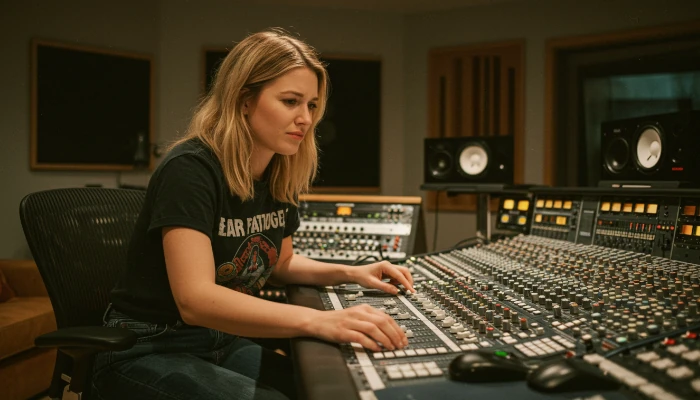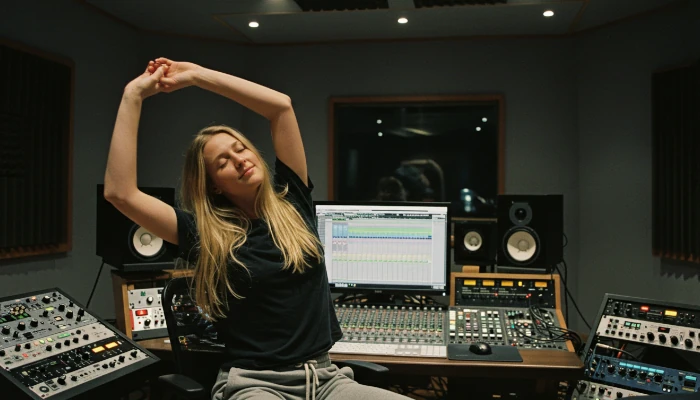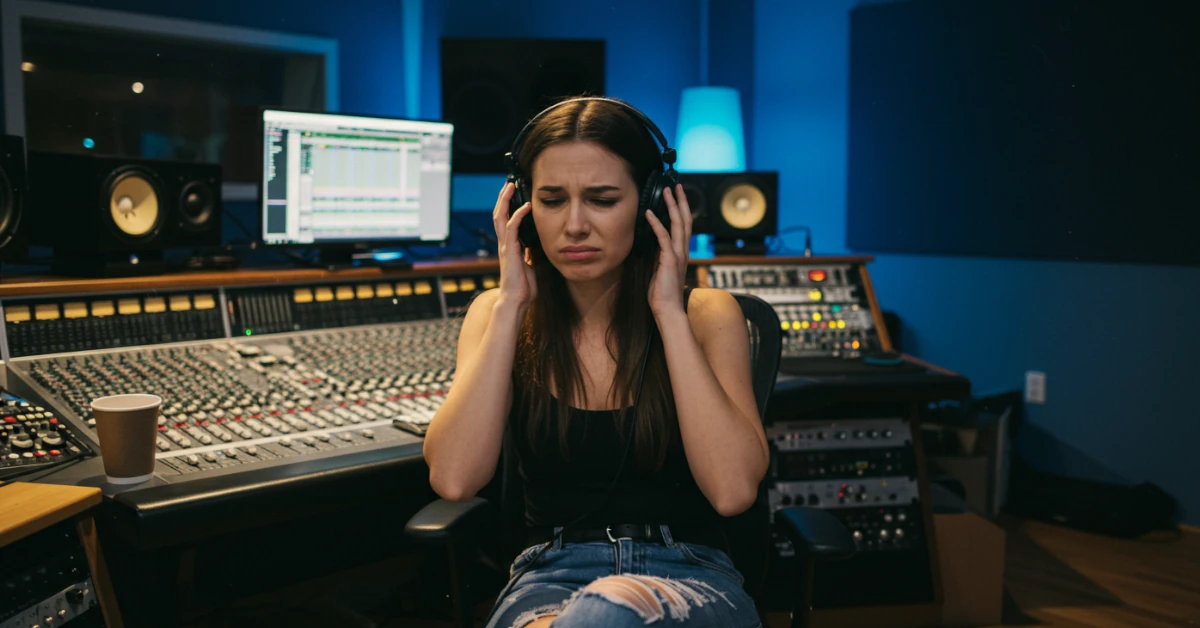Mixing for extended periods? Ear fatigue is a real concern, and this guide is your survival kit! We’ll start by Understanding Ear Fatigue: Causes and Symptoms, diving into how prolonged mixing sessions can wreak havoc on your ears, leading to muffled hearing and poor mixing decisions. Then, we’ll cover practical strategies for Avoiding Ear Fatigue in Long Sessions, emphasizing the importance of breaks, volume control, and mindful listening.
Next up is Optimizing Your Listening Environment and Gear, where we’ll explore how room acoustics, monitor placement, and headphone choice significantly impact ear fatigue.
We’ll also discuss Smart Listening Habits: Breaks, Volume, and EQ, providing actionable tips for incorporating regular breaks, setting appropriate listening levels, and using EQ effectively.
Finally, we’ll delve into Protective Measures and When to Seek Help, including the use of musician’s earplugs, lifestyle adjustments, and recognizing when it’s time to consult a professional.
Get ready to protect your ears and enhance your mixing stamina!
Understanding Ear Fatigue: Causes and Symptoms

Spending hours mixing? You’re risking ear fatigue, a sneaky enemy of good mixes. It happens when your ears get overworked, leading to inaccurate perception of sound. Causes range from excessively loud monitoring levels to focusing intensely on narrow frequency ranges for too long. Imagine “Sarah,” a home studio producer, spending six hours straight hyper-focused on the snare’s EQ. By hour five, her ears were shot, and she boosted the highs way too much! To avoid such errors, it’s helpful to master track equalization.
Symptoms include muffled hearing, a temporary threshold shift (sounds need to be louder to be heard), and a general feeling of fullness or pain in the ears. You might also find yourself making increasingly questionable mix decisions.
To avoid Sarah’s fate, take regular breaks – 5-10 minutes every hour. Lower your monitoring volume; quieter is better for long sessions. Vary what you’re listening to – switch from the mix to a reference track to reset your ears. Finally, avoid excessive caffeine or nicotine, as they can heighten sensitivity. Recognize the symptoms and stop mixing immediately if they arise. Your ears (and your mixes) will thank you! If you’re looking to enhance your mixing skills, consider exploring step-by-step mixing workflow guides.
Optimizing Your Listening Environment and Gear
Your listening environment and gear play a HUGE role in preventing ear fatigue during long mixing sessions! Think of it like this: a poorly treated room forces you to crank up the volume to hear details, leading to quicker fatigue. For those on a budget, there are options for affordable gear for a home recording studio.
Start with room acoustics. Even simple DIY acoustic panels made from rockwool or fiberglass can tame reflections and reduce harshness. Focus on treating first reflection points – the spots on your walls where sound bounces from your speakers to your ears. Next, consider your monitors. Are they accurate and appropriate for your room size? Smaller rooms benefit from top studio monitors for small spaces. Ensure they’re placed correctly, forming an equilateral triangle with your head.
Good headphones are also crucial for detailed work. Opt for open-back headphones for a more natural soundstage and less pressure build-up, but understand that they are not suitable for mixing as they don’t provide accurate low-end representation. Finally, invest in a comfortable chair and proper desk setup. Good posture reduces physical strain, indirectly helping you stay focused and less fatigued. Consider essential furniture for an efficient recording studio setup. Imagine “Mark,” who upgraded his room treatment and monitors; he noticed he could mix for hours longer without ear fatigue setting in. Small changes, big difference!
Smart Listening Habits: Breaks, Volume, and EQ

Want to mix for hours without your ears giving out? It’s all about smart listening habits. Think of your ears like muscles – they need rest!
First, schedule breaks. Seriously. Use a timer and force yourself to step away from the mix every 45-60 minutes. Even a five-minute break to stretch, grab water, and listen to something completely different (like nature sounds) can do wonders.
Second, monitor your volume. Mixing louder doesn’t equal better. In fact, it’s a direct path to ear fatigue. Aim for a comfortable listening level – you should be able to easily hold a conversation without raising your voice. Use a sound level meter app on your phone to check your SPL (Sound Pressure Level); aim for around 75-80 dB SPL. To further enhance your mixing skills, master audio mixing balance.
Finally, be mindful of EQ. Avoid constantly boosting frequencies, especially harsh high-end. Subtractive EQ (cutting frequencies) is often a better approach. Also, take a break from EQing every once in a while; let your ears rest from the intense frequency analysis. “Lisa,” a mastering engineer, found that implementing these habits drastically improved her stamina and the quality of her masters! Prioritize those habits and your ears will thank you. If you’re looking for tools to help, explore the top 10 free audio plugins.
Protective Measures and When to Seek Help
Beyond breaks and volume, proactive protection is key to avoiding ear fatigue in long sessions and preserving your hearing health. Consider using custom-molded musician’s earplugs designed to reduce volume evenly across the frequency spectrum. These aren’t your construction site earplugs; they let you hear accurately at a lower level.
Also, pay attention to your overall health. Dehydration can worsen ear fatigue, so drink plenty of water. Manage stress levels; stress makes you more susceptible to auditory strain. Download a white noise app and use it during breaks to mask any background noise and give your ears a break. For those interested in setting up a home studio, check out this guide.
But what if you’re already experiencing persistent symptoms? Don’t ignore them! If you consistently experience tinnitus (ringing in the ears), muffled hearing that doesn’t resolve quickly, or pain in your ears after mixing, seek professional help from an audiologist or ENT (Ear, Nose, and Throat) doctor. “David,” a seasoned producer, initially dismissed his tinnitus as “part of the job,” only to later discover irreversible hearing damage. Early intervention is crucial. Protect your ears; they’re your most valuable asset!
Sound Advice for Lasting Sound
Mixing for extended periods doesn’t have to mean sacrificing your hearing health. By understanding the causes and symptoms of ear fatigue, optimizing your listening environment, adopting smart listening habits like frequent breaks and mindful volume control, and taking proactive protective measures, you can safeguard your ears and extend your mixing stamina. Remember, your ears are your most valuable asset in music production. Now, go forth and mix responsibly, armed with the knowledge to keep your ears fresh and your mixes sounding their best for years to come!

